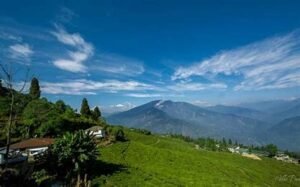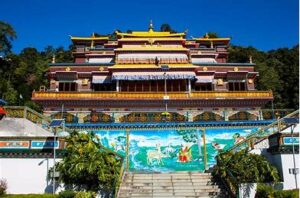Introduction: A Glimpse into Divine Heritage
Shree Govindajee Temple is one of the most important Hindu temples in Manipur. It is not just a place of worship but a cultural landmark rooted in the history and spiritual life of the people. Situated in Imphal, this temple stands as a testament to the deep devotion and traditions of Vaishnavism in the region.
Historical Roots: Echoes from the Past
Built in the early 18th century, the temple was commissioned by Maharaja Nara Singh in 1846. It was later rebuilt after an earthquake in 1868. The temple is dedicated to Lord Krishna, worshipped here as Shree Govindajee, along with Radha and other deities.
The temple’s history is closely tied to the spread of Vaishnavism in Manipur. King Pamheiba, also known as Garib Niwaz, adopted Vaishnavism and made it the state religion in the 18th century. The temple became a key symbol of this shift.
Language and Communication: Devotion in Dialogue
In rituals and songs at the temple, the Meitei language blends with Sanskrit verses. Devotional hymns, known as kirtans, are performed during daily prayers and festivals. These songs play a big role in bringing the community together in spiritual expression.
Festivals and Celebrations: Spiritual Unity in Color
Major Hindu festivals like Janmashtami, Holi, and Rath Yatra are celebrated with devotion. Janmashtami marks the birth of Lord Krishna and is one of the biggest events at the temple. Devotees fast, sing hymns, and participate in special prayers. During Rath Yatra, the deities are taken out in a grand procession, showcasing traditional music, dance, and devotion.
Arts, Crafts, and Music: Culture in Every Beat
The temple supports local artists and musicians who perform Raslila, a traditional dance drama based on the life of Lord Krishna. This art form, which combines storytelling, music, and dance, is a key part of Manipur’s cultural identity.
Handcrafted decorations, traditional attire of performers, and musical instruments like the pung (drum) reflect a deep cultural connection between religion and the arts.
Cuisine and Culinary Traditions: Sacred Flavors
During festivals and special occasions, prasadam (offering to the deity) is distributed among devotees. These offerings often include local Manipuri vegetarian dishes made from seasonal ingredients.
Rice, black gram, and vegetables are commonly used. Food plays a role in rituals, symbolizing purity, devotion, and community bonding.
Attire and Ornamentation: Dress of Devotion
Traditional attire is worn by devotees and priests during ceremonies. Men often wear white dhotis and shawls, while women wear phanek and innaphi. These garments are made using traditional handlooms.
The deities are adorned with rich clothes, jewelry, and floral garlands, reflecting both royal heritage and spiritual respect.
Beliefs and Values: Faith as a Way of Life
The temple reflects the values of love, devotion, and unity. Followers of Vaishnavism believe in the teachings of Lord Krishna—righteous living, truth, and compassion.
Daily rituals and teachings from religious texts reinforce these values in the lives of the devotees. The temple encourages harmony, humility, and devotion to the divine.
Customs and Etiquette: Respect in Rituals
Before entering the temple, devotees wash their hands and feet. Shoes are removed as a sign of respect. Silence and humility are maintained inside the temple premises.
Offerings like flowers, fruits, and incense are brought with devotion. These customs highlight the importance of purity and mindfulness during worship.
Architecture and Symbols: A Blend of Beauty and Belief
The temple’s architecture is simple yet elegant. The twin domes, arched balconies, and spacious courtyard show a fusion of traditional and Mughal styles. The sanctum houses the main deity, Shree Govindajee, along with Radha and other idols.
Symbols like the chakra (wheel) and shankha (conch) are placed around the temple. These represent divine protection and purity.
Oral Traditions and Storytelling: Keeping Faith Alive
Elders and priests share stories from the life of Lord Krishna. These oral traditions help pass on values, history, and beliefs to younger generations.
Festivals and rituals often include storytelling through song and dance, such as Raslila, keeping cultural and religious knowledge alive.
Interactions with Nature: Worship in Harmony
The temple grounds are surrounded by gardens with flowering plants and sacred trees like the Tulsi plant. Nature is an important part of rituals.
Offerings often include natural items like fruits, leaves, and flowers, symbolizing gratitude towards the earth. Devotees believe that respecting nature is a way of honoring the divine.
Challenges and Preservation: Protecting Sacred Heritage
With time, modernization and natural disasters have posed threats to the temple’s structure and traditions. The earthquake of 1868 caused major damage, but the temple was carefully restored.
Today, local authorities and cultural bodies work to maintain the temple, preserve art forms like Raslila, and protect the traditions tied to it.
Contributions to Society: A Pillar of Faith and Culture
The temple is not just a religious site—it plays a role in social harmony and cultural education. It serves as a place where people gather, share, and learn.
It supports local artisans, musicians, and storytellers. It fosters values like compassion, cooperation, and cultural pride.
Connection to Northeast India: A Shared Spiritual Thread
Shree Govindajee Temple stands as a key landmark in Northeast India’s spiritual landscape. Though rooted in Vaishnavism, it embraces local culture and traditions of the Meitei community.
It connects Manipur’s heritage to the wider spiritual fabric of India while maintaining its unique cultural identity. Through festivals, art, and rituals, it shares a piece of Northeast India’s soul with the rest of the country.
Conclusion: A Living Legacy of Devotion
Shree Govindajee Temple is more than a place of worship. It is a living symbol of culture, devotion, and community. From its historical roots to its sacred rituals, the temple continues to inspire generations with its values and traditions.
It preserves not only religious beliefs but also rich art forms, language, and social values unique to Manipur.




